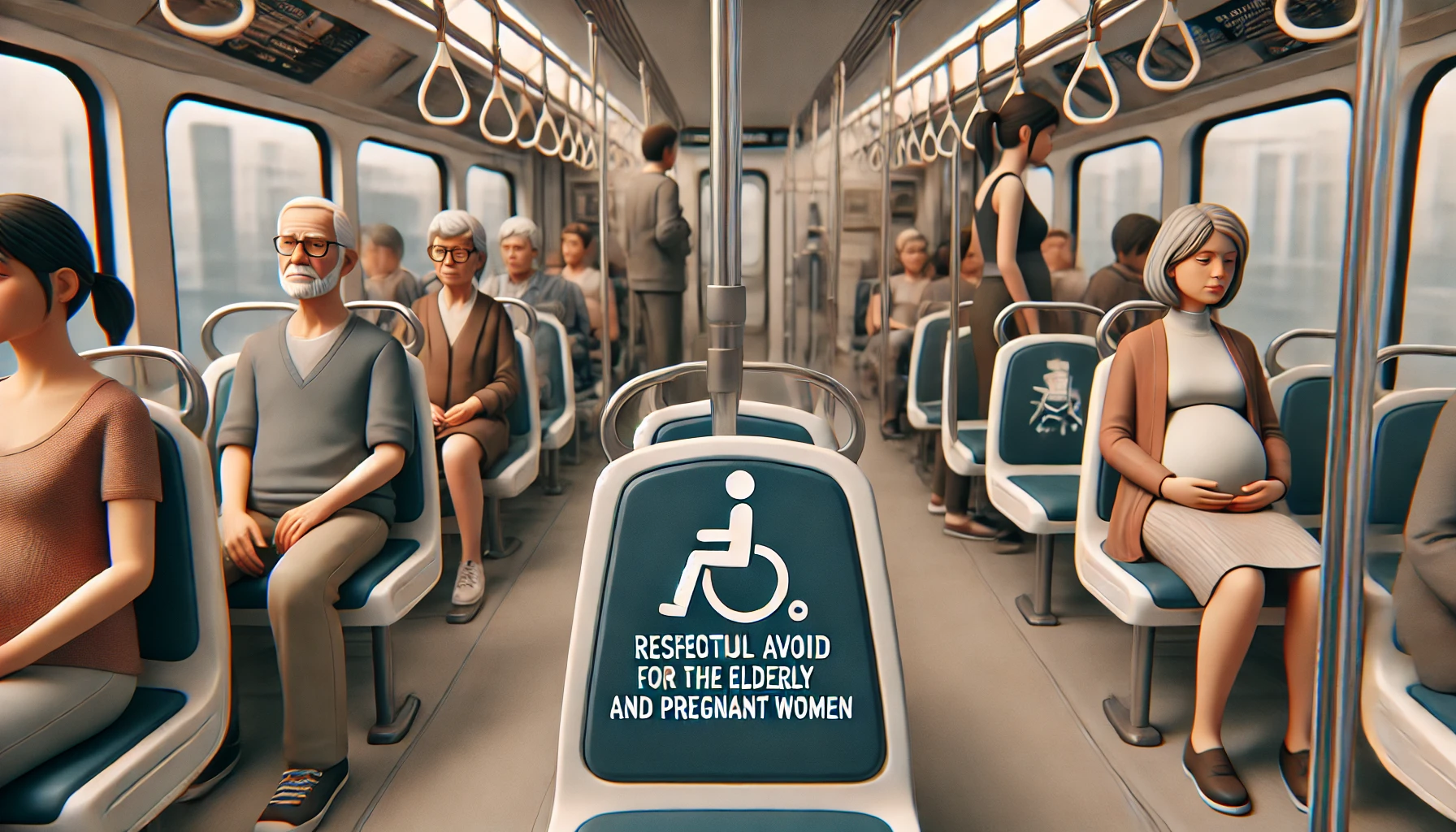The altruistic behavior of giving up seats to the elderly and pregnant on public transportation is induced by verbal and nonverbal elements of communication. This behavior is promoted by a variety of factors, including public service announcements, social gaze, and education, and can be explained to some extent from an evolutionary perspective through the communication hypothesis.
When we use public transportation, we always see empty seats for the elderly and pregnant women. If you look closely at these seats, you’ll notice that even during rush hour, the busiest time for public transportation, almost no one sits in them unless they’re the right person. From an individual’s point of view, there is no real benefit in not sitting down even though there are seats available. In public transportation, this kind of behavior is defined as altruistic when it benefits others, such as the elderly or pregnant women. An action is altruistic if it is socially valuable, but the individual has to suffer a loss, large or small, to perform it.
These altruistic cooperative behaviors are common in the world around us, but they are not well understood from an evolutionary perspective. According to evolutionary theory, individuals in a population must fight for the survival of themselves and their offspring, and altruistic behavior is not a fight for survival, so it is considered unnecessary.

So, how do we explain the reality that there are plenty of sufficiently altruistic behaviors? Let’s go back to the elderly and pregnant seats on public transportation. There are several possible reasons why healthy people do not sit in elderly and pregnant seats. First, you may see public service announcements on public transportation asking you to give up your seat to the elderly or pregnant. Even if you ignore the signs and sit down, you’ll likely receive negative reactions to your behavior, such as stares, facial expressions, etc. In other words, both verbal and nonverbal elements of communication lead to altruistic behavior, which we call the communication hypothesis.
There are many different hypotheses to explain altruistic behavior. The communication hypothesis is one of them, but it’s important to note that altruistic behavior also exists in situations where there is no communication, so let’s narrow it down to situations where communication is possible and think about why communication affects altruistic behavior.
We know from experience that it is more helpful to meet and talk to each other, and we can feel the impact of communication is significant. However, the communication hypothesis is still unexplained in theory, so there are detailed hypotheses to explain the effects of communication in the real world. Some examples include: first, communication allows us to understand how to behave in the most socially desirable way, and second, communication instills a sense of guilt in people who act unselfishly.
In the case of the elderly and pregnant seats, the people who sit in these seats are socially vulnerable, so they have a duty to protect them, and they believe that it is desirable for their relatively healthy counterparts to give up their seats, which is consistent with the first hypothesis. They understand what is socially desirable to do through communication, such as the wording of public service announcements and the education they receive from a young age. The healthy person in this position is then subjected to nonverbal cues, as discussed earlier, that make them feel like they are doing something wrong, i.e., that they are guilty of acting unselfishly. As a result, the elements of communication lead to altruistic behavior.
In the end, altruistic behavior, which is not well understood from an evolutionary perspective, is explained to some extent by the communication hypothesis. The altruistic behavior of giving up one’s seat on public transportation is a result of communication, both verbal and non-verbal. In other words, although the theory is not yet clear, we can say that communication triggers altruistic behavior in situations where communication is possible.
Some of the communication hypotheses that have been proposed to explain altruistic behavior have been debunked and others have been difficult to validate. They are currently being studied more intensively. However you understand them, it’s clear that communication is influencing people’s altruistic behavior, and it’s clear that it’s not just “cheap chit-chat”.
Additionally, we need to look at how these altruistic behaviors can be reinforced by social structures and institutions. For example, campaigns to designate and promote seats for the elderly and pregnant women on public transportation are examples of altruistic behavior that go beyond simple communication and are institutionalized. The combination of these institutional mechanisms and communications makes people naturally practice altruistic behavior. This shows that altruistic behavior does not rely solely on the voluntary morality of individuals, but can be promoted by social systems and cultural norms.
In this context, the role of education and media is also important. Moral education from an early age and campaigns through mass media can encourage people to feel socially responsible and engage in altruistic behavior. In the long run, this will contribute to increasing the frequency of altruistic behavior in society as a whole.
In conclusion, altruistic behavior is the result of a complex interplay of social, cultural, and biological factors. The communication hypothesis is one useful tool to explain this altruistic behavior, and it allows us to understand why people want to help others. While more research and discussion is needed, current research suggests that communication is an important factor in promoting altruistic behavior.
 I’m a blog writer. I want to write articles that touch people’s hearts. I love Coca-Cola, coffee, reading and traveling. I hope you find happiness through my writing.
I’m a blog writer. I want to write articles that touch people’s hearts. I love Coca-Cola, coffee, reading and traveling. I hope you find happiness through my writing.